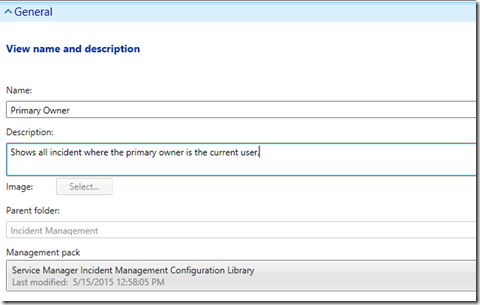Creating a View for the Primary Owner
I had a request recently to build a view which showed all Incidents where the primary owner was the console user. Sounded simple enough but took awhile because of the criteria.
As I use the Advanced View Editor so I can make columns look nicer I included what I did to customise the view below. I worked it out by looking at the inbuilt Assigned to Me view.
Create a new advanced view and fill in the basic details, select a management pack etc.
Use the Incident (Advanced) type projection. I would recommend adding the type projection management pack here so that some less intensive projections can be selected.
If I look at the XML for the Assigned to Me view it looks like the below – since I can’t select the [me] token in my new view I need to edit the XML and create something similar to the below.
<Criteria xmlns="https://Microsoft.EnterpriseManagement.Core.Criteria/">
<Expression>
<In>
<GenericProperty Path="$Context/Path[Relationship='WorkItem!System.WorkItemAssignedToUser' SeedRole='Source']$">Id</GenericProperty>
<Values>
<Token>[me]</Token>
<Token>[mygroups]</Token>
</Values>
</In>
</Expression>
</Criteria>
What I do is in my advanced view builder I select the Primary Owner and just add in a random field –e.g. Name. Then I switch to the XML view.
The XML looks like below – I just change it around a bit because to use a token (e.g. [me]) we have to use a generic property tag.
Before:
<Expression>
<SimpleExpression>
<ValueExpressionLeft>
<Property>$Context/Path[Relationship='CoreIncident!System.WorkItem.IncidentPrimaryOwner' TypeConstraint='System!System.User']/Property[Type='System!System.User']/FirstName$</Property>
</ValueExpressionLeft>
<Operator>Equal</Operator>
<ValueExpressionRight>
<Value>[me]</Value>
</ValueExpressionRight>
</SimpleExpression>
</Expression>
After:
<Expression>
<SimpleExpression>
<ValueExpressionLeft>
<GenericProperty Path="$Context/Path[Relationship='CoreIncident!System.WorkItem.IncidentPrimaryOwner' TypeConstraint='System!System.User']$">Id</GenericProperty>
</ValueExpressionLeft>
<Operator>Equal</Operator>
<ValueExpressionRight>
<Token>[me]</Token>
</ValueExpressionRight>
</SimpleExpression>
</Expression>
I create a new incident and it appears in the view.
Comments
- Anonymous
August 04, 2015
Thank you this worked fantastically!


